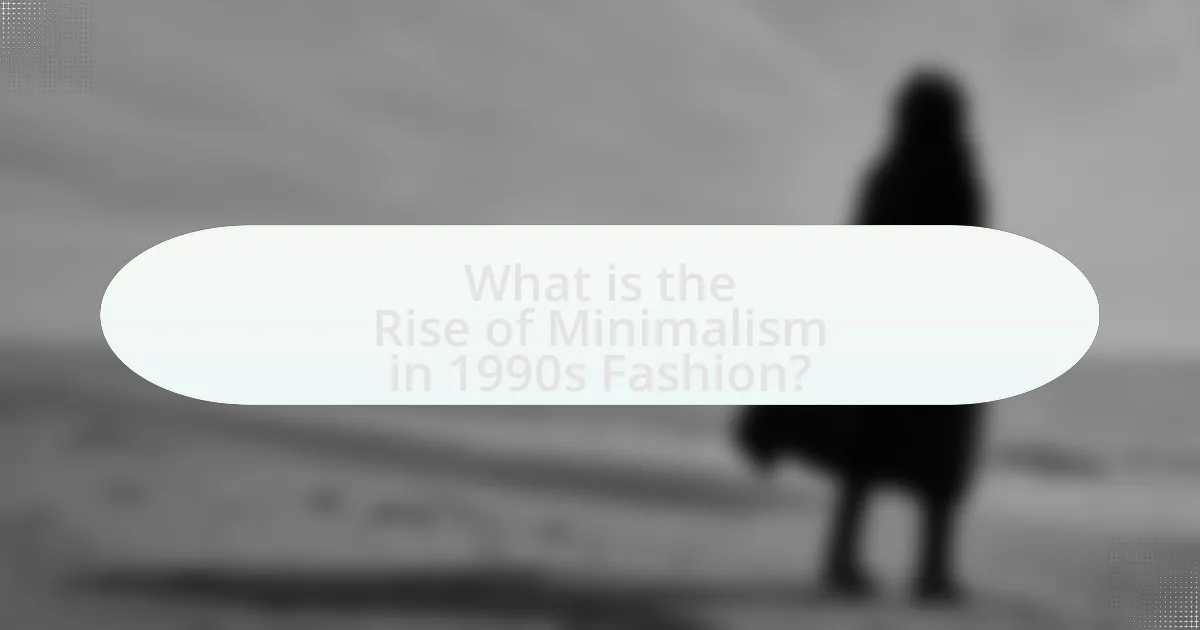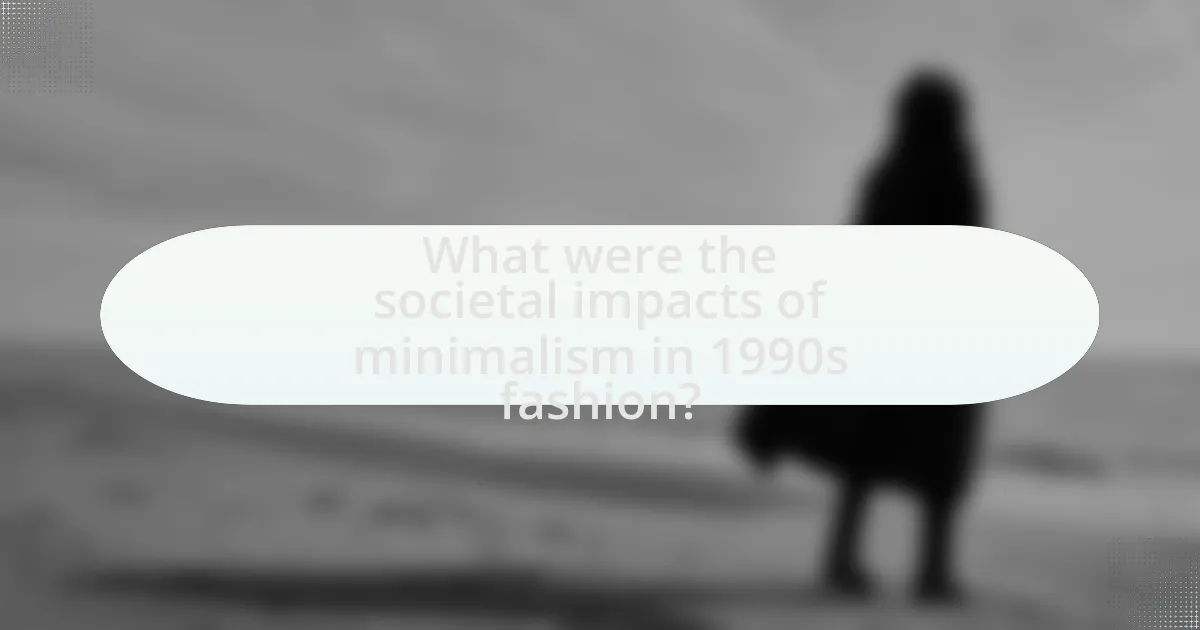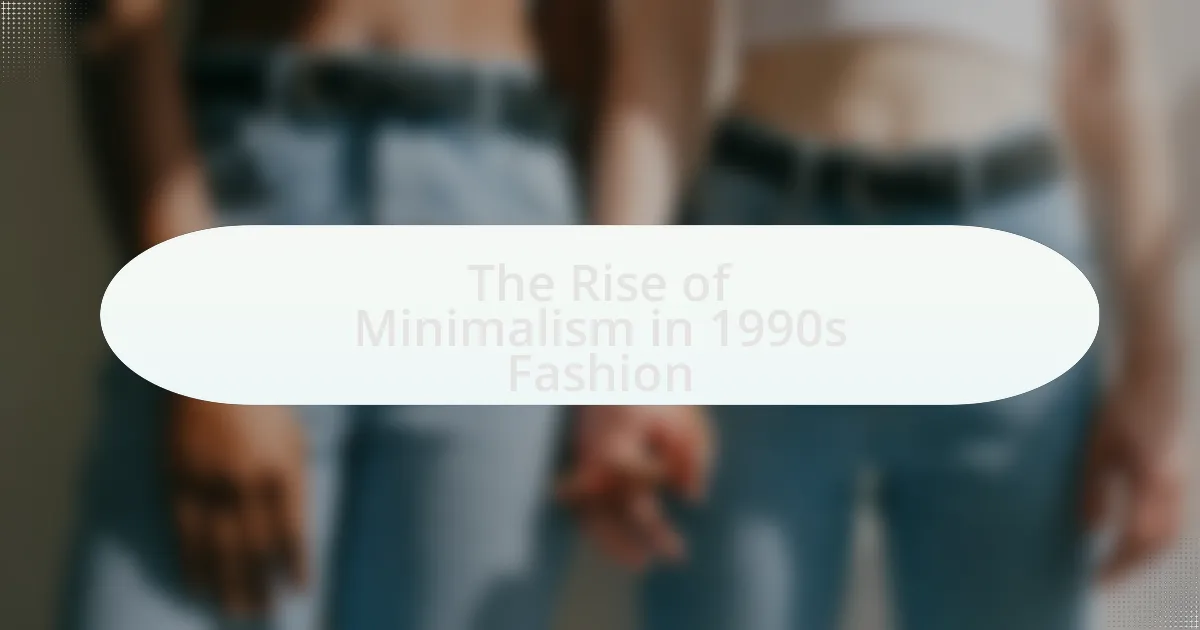The rise of minimalism in 1990s fashion marked a significant shift towards simplicity and understated elegance, characterized by clean lines, neutral colors, and a focus on quality over quantity. Influenced by designers such as Calvin Klein and Jil Sander, this movement emerged as a reaction against the excess of the 1980s and was shaped by cultural and economic factors, including the recession of the early 1990s. Key elements of this trend included tailored pieces, versatile clothing, and a minimalist aesthetic that prioritized functionality. The impact of minimalism extended beyond fashion, influencing societal attitudes towards consumerism and sustainability, and its legacy continues to resonate in contemporary fashion practices.

What is the Rise of Minimalism in 1990s Fashion?
The rise of minimalism in 1990s fashion refers to a significant shift towards simplicity and understated elegance in clothing design and aesthetics during that decade. This movement was characterized by clean lines, neutral colors, and a focus on quality over quantity, influenced by designers such as Calvin Klein and Jil Sander, who emphasized a less-is-more philosophy. The minimalist trend gained traction as a reaction against the excess and flamboyance of the 1980s, aligning with broader cultural shifts towards individualism and authenticity. The popularity of minimalism in fashion was also reflected in the rise of casual wear and the increasing importance of comfort, as seen in the adoption of simple silhouettes and versatile pieces that could be easily mixed and matched.
How did minimalism emerge as a trend in the 1990s fashion scene?
Minimalism emerged as a trend in the 1990s fashion scene due to a cultural shift towards simplicity and functionality. This movement was influenced by economic factors, such as the recession of the early 1990s, which led consumers to favor practical and versatile clothing over extravagant styles. Designers like Calvin Klein and Jil Sander championed minimalist aesthetics, emphasizing clean lines, neutral colors, and understated elegance. The popularity of minimalist fashion was further solidified by the rise of grunge and the anti-consumerist ethos, which rejected excess and embraced a more stripped-down approach to style.
What cultural and social factors contributed to the rise of minimalism?
The rise of minimalism in the 1990s fashion was primarily influenced by cultural shifts towards simplicity and a reaction against consumerism. The economic recession of the early 1990s led to a more pragmatic approach to fashion, where consumers favored quality over quantity, reflecting a desire for understated elegance. Additionally, the influence of artists and designers like Calvin Klein and Jil Sander, who emphasized clean lines and neutral palettes, reinforced this aesthetic. The cultural backdrop of the time, characterized by a growing disillusionment with excess and a focus on individualism, further propelled minimalism as a preferred style. This shift was also mirrored in the broader cultural landscape, including literature and art, where minimalism became a prominent movement, emphasizing the idea that less is more.
How did the economic climate of the 1990s influence fashion choices?
The economic climate of the 1990s significantly influenced fashion choices by promoting minimalism and practicality. During this decade, the end of the Cold War and the rise of globalization led to economic growth, but also to a recession in the early 1990s, which caused consumers to prioritize value and functionality in their clothing. As a result, fashion trends shifted towards simpler designs, neutral colors, and versatile pieces that could be worn in various settings. This shift was exemplified by brands like Calvin Klein and Jil Sander, which embraced minimalist aesthetics, reflecting a broader cultural desire for understated elegance amidst economic uncertainty.
What are the defining characteristics of 1990s minimalist fashion?
1990s minimalist fashion is characterized by simplicity, clean lines, and a neutral color palette. This style emphasized functional clothing with a focus on quality over embellishment, often featuring basic silhouettes and understated designs. Key elements included tailored pieces, such as structured blazers and straight-leg trousers, as well as the use of materials like cotton and silk that contributed to a refined aesthetic. Designers like Calvin Klein and Jil Sander were pivotal in popularizing this movement, showcasing collections that stripped away excess in favor of a more streamlined approach to fashion. The minimalist trend reflected broader cultural shifts towards simplicity and practicality during the decade.
What types of clothing and styles were popular during this era?
During the 1990s, popular clothing types and styles included minimalist designs characterized by clean lines, neutral colors, and a focus on simplicity. Key fashion items were oversized silhouettes, basic t-shirts, slip dresses, and tailored trousers, often made from high-quality fabrics. The era also saw the rise of brands like Calvin Klein and Jil Sander, which epitomized minimalist aesthetics, emphasizing functionality and understated elegance. This shift towards minimalism was a reaction against the excess of the 1980s, promoting a more refined and less ostentatious approach to fashion.
How did color palettes and materials reflect minimalist principles?
Color palettes and materials in 1990s fashion reflected minimalist principles by emphasizing simplicity, neutrality, and functionality. Designers utilized a limited color range, often favoring monochromatic schemes or muted tones such as black, white, gray, and earth tones, which aligned with the minimalist ethos of reducing visual clutter. Materials were chosen for their clean lines and understated elegance, with fabrics like cotton, linen, and silk being prevalent, as they conveyed a sense of purity and practicality. This approach not only highlighted the form and structure of garments but also promoted a lifestyle that valued quality over quantity, as seen in the works of designers like Calvin Klein and Jil Sander, who became synonymous with minimalist fashion during this era.
Who were the key designers and influencers of 1990s minimalist fashion?
The key designers and influencers of 1990s minimalist fashion include Calvin Klein, Jil Sander, and Helmut Lang. Calvin Klein’s clean lines and understated aesthetics defined American minimalism, while Jil Sander’s designs emphasized simplicity and functionality, establishing her as a leading figure in European fashion. Helmut Lang contributed to the movement with his innovative use of materials and deconstruction techniques, further shaping the minimalist aesthetic. These designers collectively influenced the fashion landscape of the 1990s, promoting a shift towards simplicity and elegance in clothing.
What impact did designers like Calvin Klein and Jil Sander have on the trend?
Designers like Calvin Klein and Jil Sander significantly shaped the trend of minimalism in 1990s fashion by promoting clean lines, understated elegance, and a focus on simplicity. Calvin Klein’s collections often featured neutral palettes and streamlined silhouettes, which resonated with the cultural shift towards minimalism during that decade. Jil Sander, known for her architectural designs and meticulous tailoring, further emphasized the minimalist aesthetic by prioritizing quality materials and functional forms. Their influence is evidenced by the widespread adoption of minimalist styles across various fashion houses, leading to a broader acceptance of simplicity as a key design principle in the 1990s.
How did fashion icons and celebrities contribute to the popularity of minimalism?
Fashion icons and celebrities significantly contributed to the popularity of minimalism by adopting and promoting simple, clean lines and understated aesthetics in their public appearances and fashion choices. For instance, figures like Kate Moss and Calvin Klein’s campaigns in the 1990s showcased minimalist styles that emphasized neutral colors and basic silhouettes, which resonated with a broader audience seeking simplicity in contrast to the excess of previous decades. This visibility in mainstream media and fashion magazines helped to establish minimalism as a desirable and aspirational lifestyle, influencing both designers and consumers to embrace a more stripped-down approach to fashion.

What were the societal impacts of minimalism in 1990s fashion?
Minimalism in 1990s fashion significantly influenced societal attitudes towards consumerism and self-expression. This movement promoted simplicity and functionality, leading to a shift away from the excess and flamboyance of previous decades. The adoption of minimalist aesthetics encouraged individuals to prioritize quality over quantity, fostering a culture of thoughtful consumption. This was evident in the rise of brands like Calvin Klein and Jil Sander, which emphasized clean lines and neutral colors, reflecting a broader societal desire for authenticity and understated elegance. The minimalist trend also resonated with the economic climate of the time, as the recession prompted consumers to seek more practical and versatile clothing options, ultimately reshaping fashion norms and consumer behavior.
How did minimalism challenge traditional fashion norms?
Minimalism challenged traditional fashion norms by prioritizing simplicity and functionality over extravagance and ornamentation. This movement, which gained prominence in the 1990s, emphasized clean lines, neutral colors, and a reduction in the number of garments, contrasting sharply with the bold patterns and excess of previous decades. Designers like Calvin Klein and Jil Sander exemplified this shift by creating collections that focused on essential pieces, thereby redefining luxury as understated rather than ostentatious. The minimalist approach not only influenced aesthetics but also encouraged a more sustainable mindset in fashion, advocating for quality over quantity and promoting a wardrobe of versatile, timeless items.
What was the reaction of the fashion industry to the minimalist movement?
The fashion industry’s reaction to the minimalist movement in the 1990s was largely positive, as it embraced simplicity and functionality, leading to a significant shift in design aesthetics. Designers like Calvin Klein and Jil Sander became prominent figures, showcasing clean lines, neutral colors, and a focus on quality over embellishment. This movement was validated by the rise of minimalist brands and the popularity of streamlined silhouettes, which resonated with consumers seeking a departure from the excesses of the 1980s. The minimalist approach not only influenced high fashion but also permeated streetwear, reflecting a broader cultural shift towards minimalism in lifestyle and consumer behavior during that era.
How did consumers respond to minimalist fashion choices?
Consumers responded positively to minimalist fashion choices in the 1990s, embracing simplicity and functionality. This shift was characterized by a preference for clean lines, neutral colors, and versatile pieces, which resonated with a growing desire for practicality and understated elegance. The popularity of minimalist designers like Calvin Klein and Jil Sander, who emphasized these elements, contributed to a significant trend where consumers sought to declutter their wardrobes and prioritize quality over quantity. Sales data from the period indicated a marked increase in minimalist apparel purchases, reflecting a broader cultural movement towards minimalism in lifestyle choices.
What role did minimalism play in the evolution of fashion sustainability?
Minimalism significantly influenced the evolution of fashion sustainability by promoting simplicity and reducing excess in clothing design and consumption. This movement encouraged consumers to prioritize quality over quantity, leading to a shift towards timeless pieces that require fewer resources to produce. The minimalist approach often emphasizes sustainable materials and ethical production practices, aligning with the growing awareness of environmental issues in the fashion industry. For instance, brands like Calvin Klein and Jil Sander, prominent in the 1990s minimalist trend, adopted practices that focused on reducing waste and fostering a more sustainable fashion ecosystem. This shift has been supported by research indicating that minimalist fashion can lead to lower carbon footprints and less waste generation, reinforcing the connection between minimalism and sustainable practices in the industry.
How did minimalist fashion promote a shift towards sustainable practices?
Minimalist fashion promoted a shift towards sustainable practices by emphasizing quality over quantity, encouraging consumers to invest in fewer, timeless pieces rather than fast fashion. This approach reduces waste and resource consumption, as minimalist designs often utilize sustainable materials and ethical production methods. For instance, brands like Jil Sander and Calvin Klein in the 1990s focused on clean lines and versatile garments, which not only appealed aesthetically but also aligned with a growing awareness of environmental issues. This shift was supported by a broader cultural movement advocating for conscious consumerism, leading to a significant reduction in the environmental impact associated with clothing production and disposal.
What lessons from 1990s minimalism can be applied to modern fashion sustainability?
The lessons from 1990s minimalism that can be applied to modern fashion sustainability include prioritizing quality over quantity and embracing timeless designs. Minimalism in the 1990s emphasized fewer, well-made pieces that could be worn across various occasions, reducing the need for excessive consumption. This approach aligns with sustainable fashion principles, which advocate for durable materials and versatile styles that extend the lifecycle of garments. Additionally, the minimalist aesthetic encourages consumers to invest in essential items rather than fast fashion, which contributes to environmental degradation. By adopting these principles, modern fashion can reduce waste and promote a more sustainable industry.

How can we understand the legacy of 1990s minimalist fashion today?
The legacy of 1990s minimalist fashion can be understood through its enduring influence on contemporary design aesthetics and consumer behavior. Minimalism from that era emphasized simplicity, clean lines, and functionality, which are now prevalent in modern fashion brands like COS and Everlane. This approach reflects a shift towards sustainable practices and a rejection of fast fashion, as consumers increasingly prioritize quality over quantity. The 1990s minimalist movement, led by designers such as Calvin Klein and Jil Sander, established a foundation for today’s emphasis on timeless pieces and versatile wardrobes, demonstrating that the principles of minimalism remain relevant in addressing current fashion challenges.
What influences of 1990s minimalism can be seen in contemporary fashion?
Contemporary fashion is significantly influenced by 1990s minimalism through the use of clean lines, neutral color palettes, and an emphasis on functionality. Designers today often draw inspiration from the minimalist aesthetic characterized by simplicity and understated elegance, which was prevalent in the 1990s. For instance, brands like The Row and Jil Sander exemplify this influence by prioritizing tailored silhouettes and high-quality fabrics, reflecting the minimalist ethos of the 1990s. Additionally, the resurgence of capsule wardrobes in contemporary fashion echoes the 1990s focus on essential pieces that can be mixed and matched, promoting a more sustainable approach to clothing consumption.
How have modern designers incorporated minimalist elements into their collections?
Modern designers have incorporated minimalist elements into their collections by emphasizing clean lines, neutral color palettes, and functional silhouettes. This approach reflects the principles established in the 1990s, where designers like Calvin Klein and Jil Sander prioritized simplicity and understated elegance. Current collections often feature versatile pieces that can be easily mixed and matched, showcasing a focus on quality materials and craftsmanship. For instance, brands such as COS and Everlane exemplify this trend by offering timeless designs that reject excess ornamentation, aligning with the minimalist ethos of sustainability and intentionality in fashion.
What are the current trends that reflect the principles of 1990s minimalism?
Current trends reflecting the principles of 1990s minimalism include the resurgence of clean lines, neutral color palettes, and functional silhouettes in fashion. Designers are emphasizing simplicity and practicality, often utilizing high-quality materials that prioritize durability over excess. For instance, brands like The Row and Jil Sander are known for their minimalist aesthetics, showcasing understated elegance through tailored pieces and monochromatic outfits. Additionally, the popularity of capsule wardrobes aligns with the 1990s minimalist ethos, encouraging consumers to invest in versatile, timeless clothing rather than fast fashion. This trend is supported by a growing consumer preference for sustainability and ethical fashion, which echoes the minimalist principle of “less is more.”
What practical tips can be drawn from the minimalist fashion movement?
Practical tips from the minimalist fashion movement include focusing on quality over quantity, selecting versatile pieces, and embracing a neutral color palette. Prioritizing quality ensures longevity and durability in clothing, which aligns with the minimalist ethos of sustainability. Choosing versatile pieces allows for multiple outfit combinations, maximizing the utility of each item. A neutral color palette simplifies coordination and enhances the timelessness of the wardrobe, making it easier to maintain a cohesive style. These strategies reflect the minimalist approach that gained prominence in the 1990s, emphasizing simplicity and intentionality in fashion choices.
How can individuals adopt minimalist principles in their own wardrobes?
Individuals can adopt minimalist principles in their wardrobes by curating a collection of versatile, high-quality clothing items that emphasize simplicity and functionality. This involves assessing current wardrobe contents, removing items that are rarely worn or do not align with a minimalist aesthetic, and focusing on neutral colors and classic styles that can be easily mixed and matched. Research indicates that minimalist fashion promotes sustainability by encouraging consumers to buy less and choose items that last longer, thereby reducing waste and environmental impact.
What are the benefits of embracing a minimalist fashion approach today?
Embracing a minimalist fashion approach today offers several benefits, including reduced decision fatigue, enhanced personal style clarity, and a more sustainable wardrobe. By focusing on fewer, high-quality pieces, individuals can streamline their choices, making daily outfit selection simpler and less stressful. This clarity allows for a more defined personal style, as each item is chosen for its versatility and fit, rather than being influenced by fleeting trends. Additionally, a minimalist wardrobe promotes sustainability by encouraging the purchase of durable, timeless clothing, which can lead to less waste and a lower environmental impact. Studies indicate that the fashion industry is responsible for a significant percentage of global waste, and adopting minimalism can help mitigate this issue by prioritizing quality over quantity.

Leave a Reply